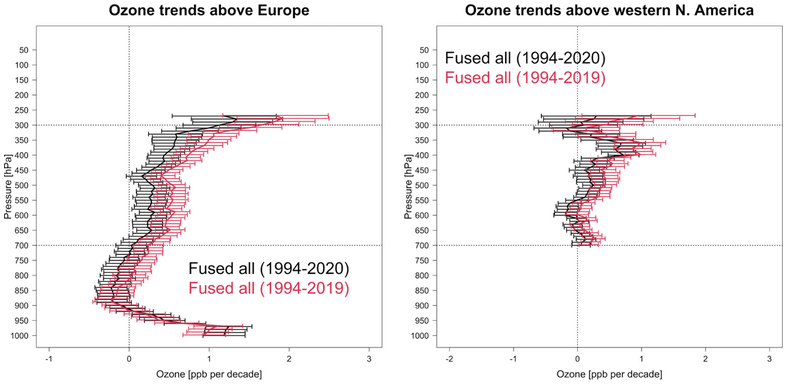A .gov website belongs to an official government organization in the United States.
A lock () or https:// means you've safely connected to the .gov website. Share sensitive information only on official, secure websites.
14 March 2022
adapted from Eos Science News by AGU, Editors' Highlight

A decrease in emissions of ozone precursor gases during the COVID-19 economic downturn likely explains the unusual reduction in ozone concentrations observed during the spring and summer of 2020.
Ozone in the free troposphere has increased across the Northern Hemisphere since the mid-1990s, up until 2020. Kai-Lan Chang et al. [2022] examine the association between the COVID-19 economic downturn and the observed anomalies in the 2020 tropospheric ozone above Europe and western North America, along with the resulting effect on long-term trends. The team developed a statistical framework to better quantify regional scale ozone anomalies throughout the depth of the troposphere and stratosphere, by combining multiple sources of vertical profile records, such as ozonesonde, lidar, and commercial aircraft data. The authors show that regional anomalies, and their associated estimation uncertainty, can be consistently and systematically quantified. Their findings show that the positive 1994-2019 ozone trends above Europe and western North America are diminished when including the large negative anomalies in 2020. Further, 2020 is the only year in which both regions show coincident and profound negative anomalies since the benchmark year of 1994.
Chang, K.-L., O.R. Cooper, A. Gaudel, M. Allaart, G. Ancellet, H. Clark, S. Godin-Beekmann, T. Leblanc, R.V. Malderen, P. Nedelec, I. Petropavlovskikh, W. Steinbrecht, R. Stubi, D.W. Tarasick, and C. Torres, Impact of the COVID-19 economic downturn on tropospheric ozone trends: an uncertainty weighted data synthesis for quantifying regional anomalies above western North America and Europe, AGU Advances, doi:10.1029/2021AV000542, 2022.
This study quantifies the association between the COVID-19 economic downturn and 2020 tropospheric ozone anomalies above Europe and western North America, and their impact on long-term trends. Anomaly detection for an atmospheric time series is usually carried out by identifying potentially aberrant data points relative to climatological values. However, detecting ozone anomalies from sparsely sampled ozonesonde profiles (once per week at most sites) is challenging due to ozone's high temporal variability. We first demonstrate the challenges for summarizing regional trends based on independent time series from multiple nearby ozone profiling stations. We then propose a novel regional-scale anomaly detection framework based on generalized additive mixed models, which accounts for the sampling frequency and inherent data uncertainty associated with each vertical profile data set, measured by ozonesondes, lidar or commercial aircraft. This method produces a long-term monthly time series with high vertical resolution that reports ozone anomalies from the surface to the middle-stratosphere under a unified framework, which can be used to quantify the regional-scale ozone anomalies during the COVID-19 economic downturn. By incorporating extensive commercial aircraft data and frequently sampled ozonesonde profiles above Europe, we show that the complex interannual variability of ozone can be adequately captured by our modeling approach. The results show that free tropospheric ozone negative anomalies in 2020 are the most profound since the benchmark year of 1994 for both Europe and western North America, and positive trends over 1994–2019 are diminished in both regions by the 2020 anomalies.